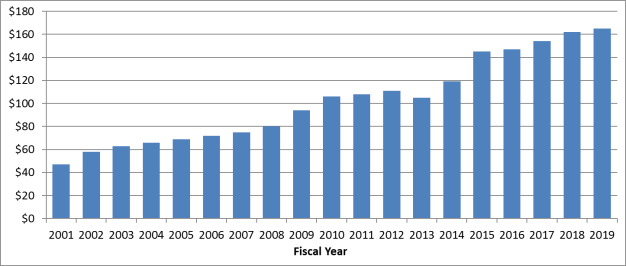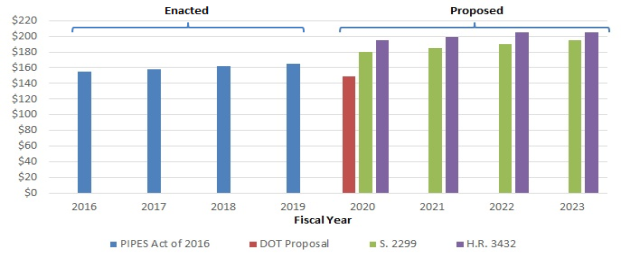Figure 1. PHMSA Pipeline Safety Total Annual Budget Authority FY2001-FY2019
(Millions of Dollars)

Sources: U.S. Office of Management and Budget, Department of Transportation.
The federal pipeline safety program is administered by the Department of Transportation's (DOT's) Pipeline and Hazardous Materials Safety Administration (PHMSA), working in partnership with state pipeline safety regulators. Together, the federal and state pipeline safety agencies administer a comprehensive set of regulatory authorities to ensure the safety of the nation's expansive network of hazardous liquid (e.g., crude oil) and natural gas pipelines. Under the Protecting Our Infrastructure of Pipelines and Enhancing Safety Act of 2016 (P.L. 114-183), funding authorization for PHMSA's pipeline safety program is set to expire after the fiscal year ending September 30, 2019. Congress is debating at what levels the program should be funded for the next four years. The Trump Administration has proposed a reduction in PHMSA pipeline safety funding whereas bills in the House and Senate propose differing increases.
PHMSA's pipeline safety program is funded primarily by user fees assessed on a per-mile basis on each regulated pipeline operator. PHMSA collects additional fees from underground natural gas storage facility operators to fund storage regulatory activities as part of its pipeline safety program. Much of PHMSA's budget is used to pay safety inspectors, either directly as federal employees or indirectly as state employees through state grants. By statute, PHMSA may pay up to 80% of the cost of personnel, equipment, and activities of a certified state pipeline safety agency. PHMSA's total annual budget authority for pipeline safety has grown somewhat steadily since 2001 (Figure 1). For FY2019, PHMSA's enacted authority is $165 million—more than double the agency's budget authority in FY2008 (not adjusted for inflation).
|
Figure 1. PHMSA Pipeline Safety Total Annual Budget Authority FY2001-FY2019 (Millions of Dollars) |
 |
|
Sources: U.S. Office of Management and Budget, Department of Transportation. |
In a pipeline safety legislative proposal transmitted to Congress on June 3, 2019, Transportation Secretary Elaine Chao proposed budget authority for PHMSA of approximately $149 million for FY2020, with "such sums as may be necessary" for fiscal years 2021 through 2023. This FY2020 budget would be roughly 10% less than the FY2019 budget authority, with proposed reductions primarily in contract programs, research and development, and grants to states. On June 26, 2019, the Energy Subcommittee of the House Energy and Commerce Committee advanced the Safer Pipelines Act of 2019 (H.R. 3432) with proposed pipeline safety budget authority of approximately $195 million in FY2020 rising to approximately $211 million in FY2023. On July 31, 2019, the Senate Commerce, Science, and Transportation Committee reported the PIPES Act of 2019 (S. 2299) with proposed budget authority of $180 million in FY2020 rising to $195 million in FY2023. Figure 2 shows these three authorization proposals. Compared to PHMSA's FY2019 budget authority, the House and Senate bills would increase PHMSA's pipeline safety authorization by roughly 18% and 9%, respectively, for the next fiscal year.
|
Figure 2. PHMSA Pipeline Safety Budget Authority FY2016-FY2023, Enacted and Proposed (Millions of Dollars) |
 |
|
Sources: U.S. Office of Management and Budget, Department of Transportation, S. 2299 as reported by the Senate Commerce, Science, and Transportation Committee; H.R. 3432 as forwarded by the House Energy and Commerce Subcommittee on Energy to the full committee. Notes: The DOT proposal contains "such sums as may be necessary" for fiscal years 2021 through 2023, and does not specify an amount for each year. |
As Congress has considered funding levels for pipeline safety, the following have been key issues:
Since the passage of the Natural Gas Pipeline Safety Act of 1968 (P.L. 90-481), which established the federal pipeline safety program, funding for pipeline safety has never lapsed. In the event that PHMSA's authorization expires before reauthorization, PHMSA officials assert that its pipeline safety program would continue to operate and could still be funded based upon its expired authorization, subject to any congressional instructions in an appropriations act. In such a case, PHMSA would look to legislative history (or at least the absence of legislative history to the contrary) to indicate that Congress did not intend for its programs to terminate. Such a circumstance would differ from a potential appropriations lapse, such as occurred during the 2018-2019 government shutdown. In that specific instance, DOT published a plan for continuing operations which included extensive furloughs of PHMSA's pipeline safety staff, primarily in administrative functions.